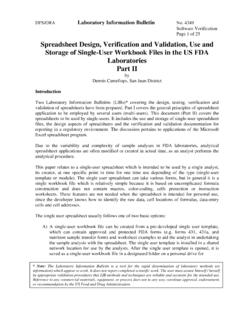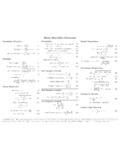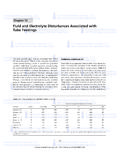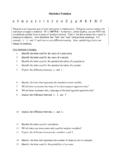Transcription of Sample Size for a Cross-Sectional, Cohort, or Clinical ...
1 Feb 16 2007 Documentation for Sample size for a cross - sectional , cohort , or Clinical Trial Studies Kevin M. Sullivan, PhD, MPH, MHA: Minn M. Soe, MD, MPH, MCTM: This module calculates Sample size for a cross - sectional study, a cohort study, or a Clinical trial. The data input screen is as follows: The four values required for a Sample size calculation are: Two-sided confidence level most individuals would choose a 95% confidence interval, but a different confidence interval could be entered. Power most individuals choose a power value of 80% or 90%, however, any power level can be entered. Ratio of Unexposed to Exposed in Sample place the desired ratio of unexposed individuals to exposed individuals.
2 If there are to be an equal number of unexposed and exposed, then enter the value of ; if there are to be twice as many unexposed as exposed, enter the value of Any other ratio can be entered. Percent of Unexposed with Outcome enter an estimate of the percentage of unexposed individuals that will develop (or have) the outcome of interest. For example, in a randomized control trial, you would estimate the percentage of those in the comparison group that will develop the outcome of interest during the trial. In a cohort study, enter the percentage of unexposed individuals who will develop the outcome of interest during the study. In a cross - sectional study, enter the estimated prevalence of disease among the unexposed.
3 The user has the choice of entering an odds ratio or the percent of exposed with the outcome of interest or the risk (prevalence) ratio or the risk (prevalence) difference - just enter one of these. The results using the default values for a risk ratio of 2 are below: Sample size for cross - sectional & cohort Studies & Clinical Trials Two-sided significance level(1-alpha): 95 Power(1-beta, % chance of detecting): 80 Ratio of Sample size , Unexposed/Exposed: 1 Percent of Unexposed with Outcome: 5 Percent of Exposed with Outcome: 10 Odds Ratio: Risk/Prevalence Ratio: 2 Risk/Prevalence difference: 5 Kelsey Fleiss Fleiss with CC Sample size - Exposed 437 436 475 Sample size -Nonexposed 437 436 475 Total Sample size : 874 872 950 References Kelsey et al.
4 , Methods in Observational Epidemiology 2nd Edition, Table 12-15 Fleiss, Statistical Methods for Rates and Proportions, formulas & CC = continuity correction The Sample size formula for the method described in Kelsey et. al. is: and where number of exposed number of unexposed standard normal deviate for two-tailed test based on alpha level (relates to the confidence interval level) standard normal deviate for one-tailed test based on beta level (relates to the power level) r = ratio of unexposed to exposed p1 = proportion of exposed with disease and q1 = 1-p1 p2 = proportion of unexposed with disease and q2 = 1-p2 and The Sample size formula without the correction factor by Fleiss is.
5 For the Fleiss method with the correction factor, take the Sample size from the uncorrected Sample size formula and place into the following formula: When the input is provided as an odds ratio (OR) rather than the proportion of exposed with disease, the proportion of exposed with disease is calculated as: When the input is provided as a risk (or prevalence) ratio (RR) rather than the proportion of exposed with disease, the proportion of exposed with disease is calculated as: When the input is provided as a risk (or prevalence) difference (RD) rather than the proportion of exposed with disease, the proportion of exposed with disease is calculated as: References Kelsey JL, Whittemore AS, Evans AS, Thompson WD.
6 Methods in Observational Epidemiology. Oxford University Press, 1996. Fleiss JL. Statistical Methods for Rates and Proportions. John Wiley & Sons, 1981. Updated Feb 16 2007: changed the - sign in the numerator of the Fleiss formula without a correction factor to +.









